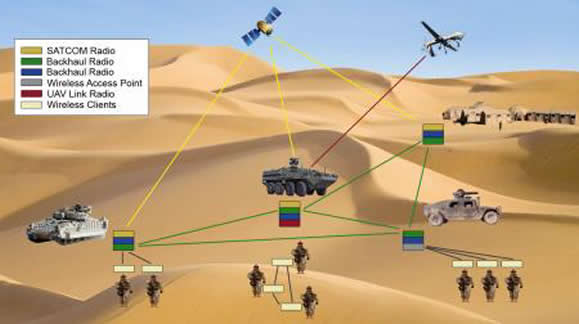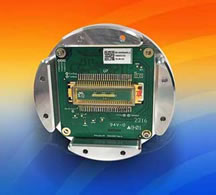Driven by technologies such as wireless data networking, wireless sensor networks (WSN), GPS, real-time video feeds from UAVs, and satellite intelligence, today’s modern military has access to a plethora of realtime data. However, getting this information to the warfighter at the “edge of the network” is still problematic and very unreliable. Getting real-time voice, data and streaming video to the warfighter at the edge is no easy task. Networking infrastructure might be in place on the battlefield, though typically it cannot support the heavier requirements of new, feature-rich applications. Warfighters are mobile and need high performance, high-bandwidth networks that move with them to deliver the information they need in real-time.
The U.S. DoD has standardized recently on IP networks to achieve the goals set out in the high-level Global Information Grid (GIG) and Network Operations (formerly Network Centric Warfare) doctrines. The goal for Network Operations is to provide seamless access to timely information to all warfighters and decision makers at every level in the military hierarchy. This enables soldiers, ground vehicles, aircraft and command centers to shape collected information into a coherent, accurate view of the battlefield. All this being said is has become apparent that mobile networks with MANET capability without IP as a transport is more secure and efficient on many networks. The SWARM can work in this manner to be more efficient and secure and connect through a gateway to IP infrastructure and high powered encryption. SWARM Intelligence is form of artificial intelligence and is self-forming, self-emerging, self healing and able learn and adapt to disruption.
Mobile Network Building Blocks with Bluetronix SWARM Intelligence
A portion of military networks can be based on fixed wired infrastructure, utilizing satellites and networking equipment in operations and command centers. But it isn’t practical or even possible to create a fixed, wired network infrastructure on a battlefield; the only practical way to provide a networking infrastructure is to create a mobile wireless network. Since most warfighters are typically in or near some sort of vehicle, an effective way to create a mobile wireless network is to make use of vehicles such as Humvees, Strykers and Bradley Fighting Vehicles to carry the infrastructure necessary to build and maintain these networks on the move (Figure 1).
 Figure 1
Figure 1
A view of a battlefield illustrating a mobile, wireless network capable of communicating voice, data/d video traffic. The networking infrastructure is located in vehicles equipped with backhaul radios and embedded routers.
Mobile wireless networks are built using a variety of IP-enabled radios and specialized embedded network routers. Network infrastructure radios are called backhaul radios, which can communicate with other backhaul radios or with satellites. Each backhaul radio is connected to a router to create a network node.
At the “edge of the network” are a variety of clients. Dismounted warfighters carry some, such as handheld radios, man-pack radios, laptops, cameras, tablets and PDAs; multiple clients can connect wirelessly to the same IP network node. There are also a variety of clients that reside inside vehicles. Often an Ethernet switch is interfaced to the router in a vehicle, providing a vehicle local area network (LAN), for clients such as radios, laptops, battlefield display systems and mission-control computers. This enables the same internetworking system in a vehicle to support both internal vehicle and external vehicle communications
simultaneously. For example, externally mounted cameras will stream video feeds to the dashboard utilizing the vehicle LAN, while in-vehicle and dismounted soldiers communicate with each other and with remote C2 installations utilizing the mobile wireless network.
Unique Challenges of Mobile Wireless Networks
The Internet was built on a fixed, static, wired infrastructure. More recently, there have been great strides in wireless and mobile connectivity. However, in the consumer and commercial world, wireless and mobile users still rely on a fixed, static, wired infrastructure. Cellular and Wi-Fi base stations and wireless routers are tied into the core networks with routing infrastructure, known gateways and Quality of Service. As a wireless or mobile user, you have to play within the rules; wireless connectivity works great in highly populated areas because that is where the infrastructure investment has been made. But as you move away
from population centers, your wireless connection will be less likely to work because of the lack of infrastructure and radio coverage.
With fixed wired networks, the network nodes are fixed, and the only components that move are clients that are not used to route other traffic, such as cellular and Wi-Fi-enabled devices. On the battlefield, not only are the clients mobile, but so are the basic building blocks of a mobile wireless network, for example the radios and specialized embedded routers. This creates a fluid and ever-changing network with dynamic nodes and frequent routing table changes. These are referred to as mobile ad hoc networks. This sets the stage well for Bluetronix SWARM and its self-forming/healing capabilities along with scalability and low initialization.
Mobile Ad Hoc Networks
A Mobile Ad hoc Network (MANET, pronounced provides a means for delivering the benefits of networking on the move to users operating beyond the reach of a fixed network. It is a self-configuring, infrastructureless network of mobile devices connected by wireless links. Each device in a MANET is free to move independently in any direction, and therefore, will change its links to other devices frequently. Each must forward traffic unrelated to its own use, and therefore participate in the routing of traffic. The primary challenge in building a MANET is equipping each network node to continuously maintain the information required to properly route traffic. Such networks may operate by themselves or may be connected to a larger network. In ad hoc networks, mobile nodes associate on an extemporaneous or ad hoc basis. Ad hoc networks have numerous distinguishing characteristics when compared with conventional networking solutions. Figure 2 lists those characteristics.
Bluetronix SWARM based Mobile Ad Hoc networks deliver a compelling advantage wherever highly mobile warfighters, unsupported by fixed infrastructure, need to share IP-based information. They offer superior information-sharing at all levels, enabling improved situational awareness, a clearer understanding of leader’s intent, and the ability for remote users to self-synchronize. The fact that they’re self-forming and self-healing facilitates deployment and minimizes the need for manual configuration and intervention. Meanwhile, their multi-hop networking nature extends network coverage and provides redundant paths for increased resilience. With ad hoc networks you also have the ability to operate with or without connectivity to a centralized network. Such networks are a key enabler for new applications such as vehicle-to-vehicle networking, intelligent transportation systems, sensor networking, telemetry monitoring and more.
Advantages of Deployed Ad Hoc Networks
| Self-forming | Nodes that come within radio range of each other can establish a network association without any pre-configuration or manual intervention. |
| Self-healing | Nodes can join or leave rapidly without affecting operation of the remaining nodes. |
| No Infrastructure | In an ad hoc network, mobile nodes form their own network and essentially become their own infrastructure. |
| Peer-to-peer | Traditional networks typically support end systems operating in client-server mode. In an ad hoc network, mobile nodes can communicate and exchange information without prior arrangement and without reliance on centralized resources. |
| Predominantly wireless | Historically, networks have been mostly wired and enhanced or extended through wireless access. The ad hoc environment is essentially wireless, but can be extended to support wired resources. |
| Highly dynamic | Mobile nodes are in continuous motion, and ad hoc networking topologies are constantly changing. |
Figure 2
Mobile Ad hoc networks have distinguishing characteristics when compared with conventional solutions.


